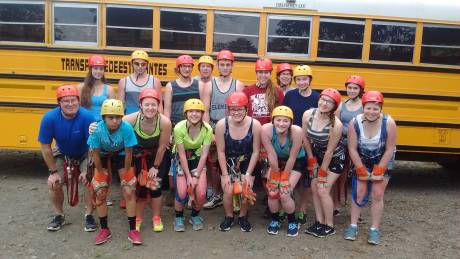
Submitted photo. Front row: Teacher Peter Spence, Maya Benda, teacher Tiffany Lucksh, Melanie MacCowan, Mackenzie Fox, Kitana Maher, Clare Fraser, Kerri Bates. Middle row: Morgan Fuller, Will Kennett, Dominick Andres, Zach Swapceinski, Olivia Audsley, Dana VanValkenburg, Isabell Bliss. Back row: Russell Flaherty, parent Michelle Geiger.
Press release:
After a year of planning, 14 students from Byron-Bergen Sr. High School traveled to Costa Rica to explore the country’s incredibly diverse habitats of rainforests, volcanoes, waterfalls and pristine ocean coastline.
Accompanied by Byron-Bergen teachers Peter Spence, who teaches Earth Science, Biology, and Chemistry, and Tiffany Luksch, who teaches Math, the young explorers arrived at the capital of San José on March 18 for an exciting seven-day expedition.
The group spent two days in Sarapiquí, a small village in the Caribbean lowlands located in the heart of the rainforest, surrounded by surreal sounds of howler monkeys, tree frogs, birds, and insects. They visited the largest active crater in the world at the Poás volcano, and experienced the cloud forest environment. A cloud forest receives little rain during the year; plants receive their moisture from the clouds that constantly shroud the volcano.
The stay in Sarapiquí also included white-water rafting (where students found tiny poison dart frogs with bright orange bodies and deep blue hind legs), and zip lining in the rainforest.
The trip continued to La Fortuna, where they visited the Mount Arenal Volcano, studied the ecological succession of plants and orchids on the once-barren lava slope, and kayaked on the man-made Lake Arenal. Students hiked to the La Fortuna waterfall and explored the Baldi hot springs.
Moving on to Guanacaste, the group saw the second-largest dry forest in the world and visited Rincòn de la Vieja Volcano. They learned how Costa Rica uses the steam generated by the thermal vents to create electricity. A riverboat ride at Palo Verde National Park offered views of crocodiles, iguanas, red macaws, and white-faced capuchin monkeys. Snorkeling in the Pacific Ocean ended the extraordinary trip.
For many of the students, this amazing educational experience was the first time they had flown or been outside the United States. It was a great opportunity to not only learn about geology, ecosystems, and biology, but also gain practical fluency in Spanish.
“All of our kids have taken Spanish and a couple of them used Spanish a lot,” Spence said. “I did rely on them to communicate when I could not.”
Upon their return, student Clare Fraser summed up the feelings of her traveling companions.
“This has been an amazing experience that I will always remember. The trip was better than I had ever expected, and it has encouraged me to travel more in the future.”
